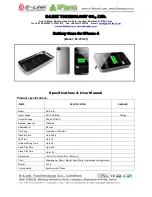
Section 16: Health and Safety Information
209
Care and Maintenance
•
Do not leave the battery in hot or cold places, such as in a car in
summer or winter conditions, as you will reduce the capacity
and lifetime of the battery. Always try to keep the battery at
room temperature. A phone with a hot or cold battery may
temporarily not work, even when the battery is fully charged.
Li-ion batteries are particularly affected by temperatures below
0 °C (32 °F).
•
Do not place the phone in areas that may get very hot, such as
on or near a cooking surface, cooking appliance, iron, or
radiator.
•
Do not get your phone or battery wet. Even though they will dry
and appear to operate normally, the circuitry could slowly
corrode and pose a safety hazard.
•
Do not short-circuit the battery. Accidental short- circuiting can
occur when a metallic object (coin, clip or pen) causes a direct
connection between the + and - terminals of the battery (metal
strips on the battery), for example when you carry a spare
battery in a pocket or bag. Short-circuiting the terminals may
damage the battery or the object causing the short-circuiting.
•
Do not permit a battery out of the phone to come in contact with
metal objects, such as coins, keys or jewelry.
•
Do not crush, puncture or put a high degree of pressure on the
battery as this can cause an internal short-circuit, resulting in
overheating.
•
Dispose of used batteries in accordance with local regulations.
In some areas, the disposal of batteries in household or
business trash may be prohibited. For safe disposal options for
Li-Ion batteries, contact your nearest Samsung authorized
service center. Always recycle. Do not dispose of batteries in a
fire.
Care and Maintenance
Your phone is a product of superior design and
craftsmanship and should be treated with care. The
suggestions below will help you fulfill any warranty
Summary of Contents for BlackJack
Page 16: ...16 ...
Page 46: ...46 ...
Page 56: ...56 ...
Page 98: ...98 ...
Page 104: ...104 ...
Page 122: ...122 ...
Page 130: ...130 ...
Page 140: ...140 ...
Page 144: ...144 ...
Page 164: ...164 ...
Page 180: ...Section 15 Troubleshooting 180 ...
Page 181: ...Section 15 Troubleshooting 181 ...
Page 182: ...Section 15 Troubleshooting 182 ...
Page 183: ...Section 15 Troubleshooting 183 Program Problems ...
Page 184: ...184 ...
Page 212: ...212 ...













































